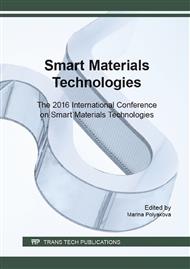p.61
p.66
p.71
p.77
p.87
p.92
p.97
p.105
p.112
Early Mobilization Using Heat Treated Shape Memory Alloy (SMA) for Rehabilitation Phases
Abstract:
Shape Memory Alloy (SMA) is a material with the ability to return to its original position, when being subjected to an appropriate thermo mechanical procedure. SMA find very wide applications in various facets of robotic and bio medical engineering. In this paper, review on ankle/foot diseases and the effective use of heat treated SMA was carried out. The manufacturing industry normally uses a range of between 200°C to 400°C to shape any biomedical product which has been used as the benchmark temperature throughout this research. The results suggested that annealing of 200°C produced the best suited for generating substantial displacement which can promote early rehabilitation of ankle/foot.
Info:
Periodical:
Pages:
112-116
Citation:
Online since:
December 2016
Price:
Сopyright:
© 2017 Trans Tech Publications Ltd. All Rights Reserved
Share:
Citation:


